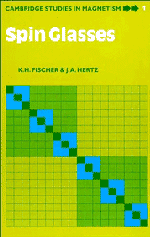Book contents
- Frontmatter
- Contents
- Preface
- 1 Introduction
- 2 Models, order parameters, and systems
- 3 Mean field theory I: Ising model, equilibrium theory
- 4 Introduction to dynamics
- 5 Mean field theory II: Ising dynamics
- 6 Mean field theory III: vector spins
- 7 Short-range interactions: low-temperature properties
- 8 Beyond mean field theory
- 9 Dynamics on many time scales
- 10 Specific heat, sound propagation, and transport properties
- 11 Competition between spin glass and ferromagnetic or antiferromagnetic order
- 12 One-dimensional models
- 13 Random field and random anisotropy
- 14 The physics of complexity
- 15 A short history of spin glasses
- References
- Index
10 - Specific heat, sound propagation, and transport properties
Published online by Cambridge University Press: 01 June 2011
- Frontmatter
- Contents
- Preface
- 1 Introduction
- 2 Models, order parameters, and systems
- 3 Mean field theory I: Ising model, equilibrium theory
- 4 Introduction to dynamics
- 5 Mean field theory II: Ising dynamics
- 6 Mean field theory III: vector spins
- 7 Short-range interactions: low-temperature properties
- 8 Beyond mean field theory
- 9 Dynamics on many time scales
- 10 Specific heat, sound propagation, and transport properties
- 11 Competition between spin glass and ferromagnetic or antiferromagnetic order
- 12 One-dimensional models
- 13 Random field and random anisotropy
- 14 The physics of complexity
- 15 A short history of spin glasses
- References
- Index
Summary
Specific heat, sound propagation, and transport properties have in common that they all are determined by the spin excitations, provided one subtracts contributions due to phonons and conduction electrons. For the specific heat, this is obvious since the heat capacity is a direct measure of the degrees of freedom of the system. The magnetic contribution to the resistivity and other transport properties of metallic spin glasses is due to the exchange coupling between the localized spins and the spins of the conduction electrons. This coupling leads to the scattering of conduction electrons by spin excitations and therefore to a resistivity which has some similarity with that due to electron–phonon scattering. The mechanism which leads to ultrasound attenuation and to a change of sound velocity is slightly more complicated. The sound waves modulate the exchange interactions Jij between the spins and therefore ‘feel’ the spin excitations. In the specific heat and transport properties, the spin excitations enter in the form of integrals, which makes it plausible that no dramatic effects are seen in the freezing temperature. This is in contrast to sound propagation, which is directly determined by the dynamic susceptibility, as shown below.
Specific heat
We mentioned already in the Introduction that (at least at first sight) the magnetic contribution CM to the specific heat shows no anomaly at the freezing temperature Tf (see Fig. 1.8). This was taken as evidence against a possible phase transition.
Information
- Type
- Chapter
- Information
- Spin Glasses , pp. 301 - 318Publisher: Cambridge University PressPrint publication year: 1991
